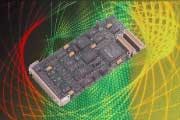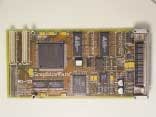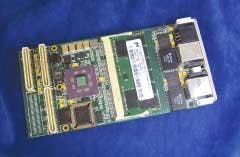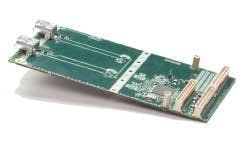Product Focus: PMC frame grabbers attack military market
VME board manufacturers are looking to PMC add-in modules to provide image-capture capability.
By Andrew Wilson, Editor
At last year’s Bus and Board Conference (January 2004; Long Beach, CA, USA), J. Eric Gulliksen, embedded hardware group manager at Venture Development Corp., provided an overview of the merchant embedded-computer-board market. In his presentation, Gulliksen showed a breakdown by bus structure of the estimated $2348 million market. While the PCI bus represented only about $557 million of the total market, the share of VME- and Compact-PCI-based products was a healthy $727 million and $609 million, respectively. Perhaps more interesting, of the $179 million global merchant mezzanine market in 2003, $134 million was in PC mezzanine-card (PMC) based sales (see Fig. 1).
PC-based buses evolved from the Industry Standard Architecture (ISA) bus in 1982 and the Extended ISA (EISA) through to today’s Peripheral Component Interconnect (PCI) bus. The original PCI bus was designed to operate with a 33-MHz clock and to provide data-transfer speeds of 132 Mbytes/s. Later PCI-X high-performance versions doubled the maximum clock frequency from 66 to 133 MHz, enabling communication at speeds greater than 1 Gbyte/s. PCI-X 2.0, the current revision, increases speed and performance even further. Maximum clock frequencies of 266 and 533 MHz are now supported to permit transfers of up to 4.3 Gbytes/s of bandwidth-32 times faster than the original PCI 2.1 specification.
While PC vendors rushed to embrace these new standards, the VME community was not standing still. Originally developed in 1979 as the VERSAbus specification to support Motorola’s 68000 processor, the bus emerged as the VERSAbus-E, which was later renamed the VMEbus with theoretical data-transfer rates for 32-bit transfers of 40 Mbytes/s. In 1995, this architecture was extended to multiplex 32 bits of data onto address lines to achieve 64-bit transfers during a VMEbus block transfer.
The new standard became known as VME64. To extend the standard further, the VME64x specification outlines a method to transfer data on both the rising edge and the falling edge of the transfer signal, thus doubling the peak block-transfer rate from 80 to 160 Mbytes/s. In 1997, the introduction of the VME320 increased this data rate to 320 Mbytes/s though the use of a novel backplane design developed by Drew Berding at Arizona Digital. The VMEbus International Trade Association (VITA) endorsed this in 1997 as part of the 2eSST VME protocol.
MARRYING THE BENEFITS
As both the VME and PC buses found market niches, many manufacturers realized that a marriage of the benefits of both would prove beneficial to OEMs. With this in mind, the CompactPCI standard was initiated in 1994 by Ziatech (now part of Intel) under the auspices of the PCI Industrial Computer Manufacturer’s Group (PICMG). As an industrial bus based on the standard PCI electrical specification, the standard incorporates the 3U or 6U Eurocard packaging used by VME boards. Unlike its desktop counterpart, Compact-PCI boards use a 2-mm metric pin and socket connector and, like the VME standard, allows I/O connections from the front or rear of the chassis.
Because of the relatively large form factor associated with 6U CompactPCI- and VME-based boards, many vendors wanted to implement simple I/O functions such as image capture, networking, and display through the use of add-in boards. Realizing that such functions required low-cost small-form-factor implementations, developers designed the PMC as a combination of two standards: IEEE P1386 Mechanics for a Common Mezzanine Card Family (CMC) and IEEE P1386.1 Physical and Environmental Layers for PMC.
While the CMC provides the mechanical and interconnect standard for a mezzanine module, the PMC specification maps PCI signals onto CMC defined interconnects. “Originally, the PMC specification relied on the carrier’s host processor,” says Jeff Munch of Adlink Technology. “To overcome this limitation, VITA developed the VITA 32 specification that defines the signals necessary to allow PMC cards to include processing capability. This opened the door for a new family of PMC modules called Processor PMCs.”
Originally, the PMC standard only supported 33- and 66-MHz PCI operation, but in 2002 VITA added support for PCI-X operation in the form of the VITA 39 specification to allow PMC cards to support 66-, 100-, and 133-MHz PCI-X transactions. “The sharing of the PCI bus between on-card processors and the PMC can lead to other unforeseen operational challenges,” says Munch. “If the local PCI bus is running at PCI-X 133-MHz and a 33-MHz PMC is installed, then the system will run at 33 MHz. Care should be taken when using PMC carriers that support PCI-X speeds to ensure that the impact to any other device that shares the PCI bus is identified,” he says.
PMC DIGITIZERS
A number of PMC cards are currently available to digitize images from both analog and digital sources (see table on p. 76). Of the manufacturers that build these products, many have targeted the standard broadcast analog formats such as RS-170, NTSC, and S-Video. Using low-cost image digitizers originally built for high-volume television applications, these modules allow both VME and CompactPCI hosts to be used for image digitization. While products from Active Silicon, Curtiss-Wright, and Leutron Vision only allow images to be captured to host memory, others such as the RG-101 from Rastergraf allow images from NTSC, PAL, and SECAM sources to be both digitized and displayed using an on-board display controller (see Fig. 2).
Since the first Camera Link interface specification was published, most PC frame-grabber vendors, including Coreco Imaging, Euresys, Matrox, and National Instruments, have introduced add-in products for the PCI and even PCI Express standards. When performing digital image acquisition using the Camera Link standard on a PMC card, however, systems integrators are limited in the number of products available. And, while companies such as Active Silicon produce Camera Link frame-grabber boards for the PMC, the size of the connector limits the frame grabber to the Base configuration, which only requires a single connector.
The availability of a smaller connector would allow Base, Medium, and perhaps Full configurations to be supplied on a single PMC board. The Camera Link committee of the Automated Imaging Association is debating introducing a smaller version of the Camera Link connector.
At Vision 2004 (Stuttgart, Germany), the Camera Link committee once again met to discuss the future of the connector (see Vision Systems Design, Dec. 2004, p. 9). Tentatively dubbed “”Mini-CL,” this connector is likely to be finalized at the next International Robots and Vision Show in September 2005.
One of the major trends in the machine-vision industry last year was endorsement of Gigabit Ethernet by camera, peripheral, and software vendors. Pleora Technologies led this advance with the introduction of its iPORT IP engines that allow analog-, digital-, LVDS-, and Camera Link-based cameras to interface to GigE networks.
Camera vendors, such as Dalsa and JAI Pulnix, have worked with Pleora to either use the company’s products to interface to GigE networks or embed the interface into a cameras targeted at machine-vision applications. Others, such as Tattile, have independently developed GigE-compatible cameras.
FIGURE 3. To interface Gigabit Ethernet cameras to VME or CompactPCI products, developers can choose PMC boards from companies such as Extreme Engineering (top). For FireWire cameras, boards such as the PFIR-PMC 1394 FireWire from Synergy Microsystems can be used (bottom).
null
null
With the interest in Gigabit Ethernet, the types and number of companies that will be able to interface such products to host PCI, VME, and CompactPCI boards will likely as not change the face of certain parts of the imaging market. To interface a GigE camera to VME or CompactPCI products, for example, developers could choose PMC boards from a number of established networking vendors such as Advantech, Concurrent Technologies, Extreme Engineering Solutions, Force Computers, and Image-Stream (see Fig. 3).
Developed primarily for the consumer-electronics industry, both the IEEE 1394 (FireWire) and USB interfaces are primarily plug-and-play bus architectures that allow devices from different vendors to operate in an open architecture. Despite the emergence of a number of low-cost digital FireWire cameras from companies such as such as Basler, MetaControls (now part of Adept Technology), and Sony Electronics, few add-in interface boards are available in PMC format. A number of camera vendors, including Electrim and MuTech, offer digital cameras with USB interfaces. Yet, despite broad industry support, plug-and-play installation, and the cost-effectiveness of such bus interfaces, only a few USB-based PMC cards are available from companies such as BVM Limited, SBC Designs, Synergy Microsystems, and Technobox.
Perhaps the main reason for the lack of both PMC FireWire and USB interface cards is the ease of implementation of such interfaces. Rather than offer the cards, many VME and CompactPCI card vendors incorporate these interfaces directly on their CPU cards. In the design of its C103 750FX PPC-based VME single-board computer, for example, Rugged Computer Systems has integrated two 1394a FireWire ports and two USB 2.0 ports directly on the card. Similarly, in its CC8-1-Blues 3U Compact PCI board, EKF Elektronik offers a host Celeron architecture coupled with several interfaces that include Ethernet, Dual IEEE 1394 FireWire, USB ports, and video output.
All switch
When choosing which bus architecture to use there is a price/performance trade-off that encompasses CPU speed, bus architecture and functionality, form factor, ruggedness, and peripheral-component availability. While these trade-offs must always be considered, the fundamental change about to take place in the merchant computer board and mezzanine add-in market will provide new challenges for PC, VME, and CompactPCI vendors and systems developers alike. With shared bus schemes such as PCI and VME, boards on the bus must use arbitration schemes to distribute the resources of the bus. In the next generation of switched-fabric networks, a switch prioritizes packets, so that real-time image data can take priority over other packets.
In the PC world, switched-fabric networks will replace the multiple, parallel buses with PCI Express links with one or more lanes. Because each link is individually scalable by adding more lanes, additional bandwidth can be applied to those links where it is required. On the VME bus, the implementation of the VMEbus Switched Serial Standard (VXS) or VITA 41 standard will provide OEMs with up to 50 times more bandwidth than the VME64 parallel bus on individual board-to-board transfers, for a total of up to 900 times more aggregate bandwidth in a maximum VXS configuration. By adopting this standard, manufacturers will offer products incorporating switched serial fabrics such as InfiniBand, Serial RapidIO, Fibre Channel, and 10 Gigabit Ethernet, while continuing to benefit from investments in the VME form factor.
Vendors of add-in PMC-based image-capture and other peripherals will also be impacted by the migration from shared-bus schemes to switched fabrics. Just as the PCI standard will evolve into the PCI Express, the established PMC mezzanine standard will evolve as switched mezzanine cards (XMCs). This XMC standard, also developed by VITA, is organized as a base standard called VITA 42.0, and several subsidiaries that map a specific switched fabric interface to the VITA 42 standard framework. These are designated as 42.1 for Parallel RapidIO, 42.2 for Serial RapidIO, and 42.3 for PCI Express.
Click here to vew VME Board Vendors in pdf.
Company Info
Adept Technology,Livermore,
CA, USAwww.adept.com
Automated Imaging Association,
Ann Arbor, MI, USAwww.machinevisiononline.org
Basler,
Ahrensburg, Germanywww.baslerweb.com
Coreco Imaging,
St.-Laurent, QC, Canadawww.imaging.com
Dalsa,
Waterloo, ON, Canadawww.dalsa.com
Electrim,
Princeton, NJ, USAwww.electrim.com
Euresys,
Angleur, Belgiumwww.euresys.com
Intel,
Santa Clara, CA, USAwww.intel.com
JAI Pulnix,
Sunnyvale, CA, USAwww.jaipulnix.com
Matrox,
Dorval, QC, Canadawww.matrox.com
MuTech,
Billerica, MA, USAwww.mutech.com
National Instruments,
Austin, TX, USAwww.ni.com
PCI Industrial Computer Manufacturer’s Group, Wakefield, MA, USAwww.picmg.org
Pleora Technologies,
Kanata, ON, Canada www.pleora.com
Sony Electronics,
Park Ridge, NJ, USA www.sony.com/videocameras
Tattile,
Bedford, NH, USAwww.tattileusa.com
Venture Development Corp.,
Natick, MA, USAwww.vdc-corp.com
VITA Standards Organization,
Fountain Hills, AZ, USAwww.vita.com





